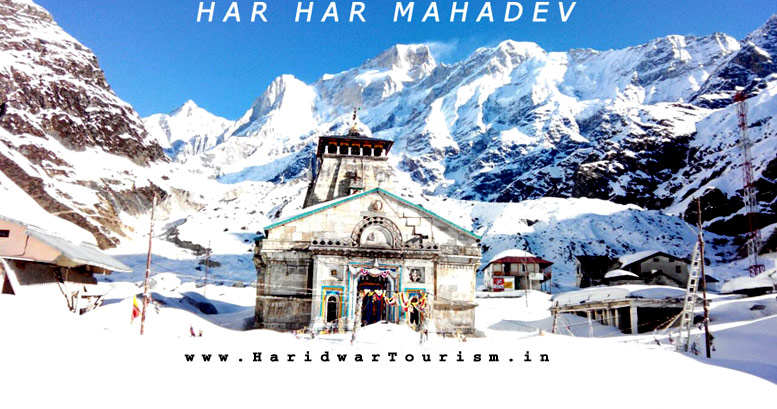|
Kedarnath Mandir - Kedarnath Temple - Kedarnath Dham is
a Hindu temple (shrine) dedicated to Lord Shiva. Located on
the Garhwal Himalayan range near the Mandakini river, Kedarnath
is located in the state of Uttarakhand, India. Due to extreme
weather conditions, the temple is open to the general public
only between the months of April (Akshaya Tritriya) and November
(Kartik Purnima, the autumn full moon). During the winters,
the vigrahas (deities) from Kedarnath temple are carried down
to Ukhimath and where the deity is worshiped for the next
six months. Kedarnath is seen as a homogenous form of Lord
Shiva, the 'Lord of Kedar Khand', the historical name of the
region.

The Kedarnath Mandir - Kedarnath Temple - Kedarnath Dham
is not directly accessible by road and has to be reached by
a 22 kilometres (14 mi) uphill trek from Gaurikund. Pony and
manchan service is available to reach the structure. According
to Hindu legends, the temple was initially built by Pandavas,
and is one of the twelve Jyotirlingas, the holiest Hindu shrines
of Shiva. It is one of the 275 Paadal Petra Sthalams, expounded
in Tevaram. Pandavas were supposed to have pleased Shiva by
doing penance in Kedarnath.The temple is one of the four major
sites in India's Chota Char Dham pilgrimage of Northern Himalayas.
This temple is the highest among the 12 Jyotirlingas.

Kedarnath was the worst affected area during the 2013 flash
floods in North India. The temple complex, surrounding areas,
and Kedarnath town suffered extensive damage, but the temple
structure did not suffer any "major" damage, apart from a
few cracks on one side of the four walls which was caused
by the flowing debris from the higher mountains. A large rock
among the debris acted as a barrier, protecting the temple
from the flood. The surrounding premises and other buildings
in the market area were heavily damaged
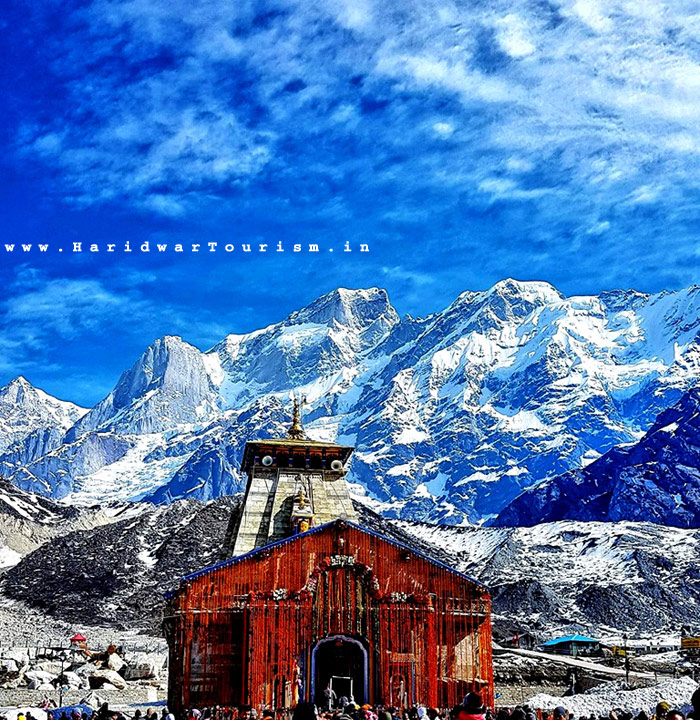
The Badrinath Dham temple is mentioned in ancient religious
texts like Vishnu Purana and Skanda Purana. It is glorified
in the Divya Prabandha, an early medieval Tamil canon of the
Azhwar saints from the 6th–9th centuries AD
History and legends of origins of Kedarnath Mandir - Kedarnath
Temple - Kedarnath Dham
The temple, at a height of 3,583 m (11,755 ft), 223 km from
Rishikesh, on the shores of Mandakini river, a tributary of
Ganga, is a stone edifice of unknown date. It is not certain
who built the original Kedarnath temple and when. The name
"Kedarnath" means "the lord of the field": it derives from
the Sanskrit words kedara ("field") and natha ("lord"). The
text Kashi Kedara Mahatmya states that it is so called because
"the crop of liberation" grows here.

According to a mythological account, the god Shiva agreed
to dwell here at the request of Nara-Narayana. After the Kurukshetra
War, the Pandava brothers, came here to meet Shiva on the
advice of the sage Vyasa, because they wanted to seek forgiveness
for killing their kin during the war. However, Shiva did not
want to forgive them: so, he turned into a bull and hid among
the cattle on the hill. When the Pandavas managed to track
him, he tried to disappear by sinking himself head-first into
the ground. One of the brothers grabbed his tail, forcing
him to appear before them and forgive them. The Pandava brothers
then built the first temple at Kedarnath. The portions of
Shiva's body later appeared at four other locations; and collectively,
these five places came to be known as the five Kedaras ("Panch
Kedar"); the head of the bull appeared at the location of
Rudranath.
The Mahabharata, which gives the account of the Pandavas and
the Kurukshetra War, does not mention any place called Kedarnath.
One of the earliest references to Kedarnath occurs in the
Skanda Purana (c. 7th-8th century), which contains a myth
describing the origin of the Ganges river. The text names
Kedara (Kedarnath) as the place where Shiva released the holy
water from his matted hair.
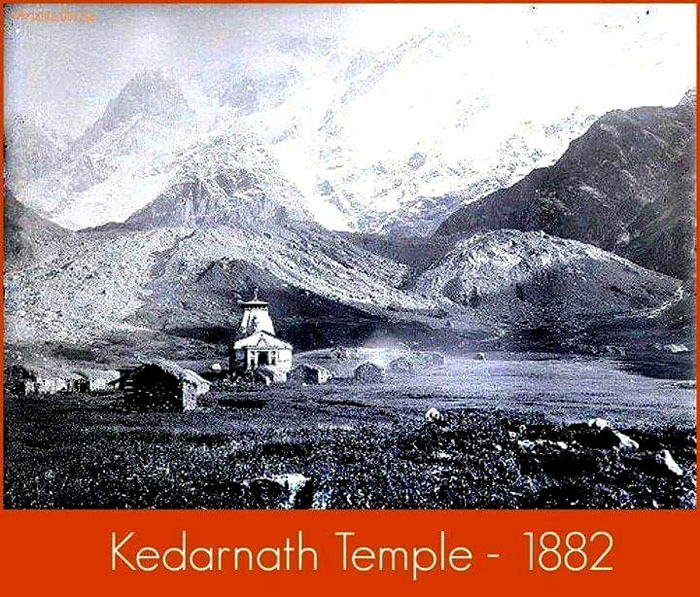
According to the hagiographies based on Madhava's Sankshepa-shankara-vijaya,
the 8th century philosopher Adi Shankara died at Kedaranatha
(Kedarnath); although other hagiographies, based on Anandagiri's
Prachina-Shankara-Vijaya, state that he died at Kanchi. The
ruins of a monument marking the purported death place of Shankara
are located at Kedarnath. Kedarnath was definitely a prominent
pilgrimage centre by the 12th century, when it is mentioned
in Kritya-kalpataru written by the Gahadavala minister Bhatta
Lakshmidhara.
According to a tradition recorded by the English mountaineer
Eric Shipton (1926), "many hundreds of years ago", the Kedarnath
temple did not have a local priest: the priest of the Badrinath
temple used to hold services at both the temples, traveling
between the two places daily.
Inside Kedarnath Mandir - Kedarnath Temple - Kedarnath
Dham
The presiding image of Kedarnath in the form of lingam is
of irregular shape with a pedestal 3.6 m (12 ft) in circumference
and 3.6 m (12 ft) in height. There is a small pillared hall
in front of the temple, that has images of Parvathi and of
the five Pandava princes. There are five temples around namely
Badari-kear, Madhya Maheswara, Tunganatha, Rudranatha and
Kallesvara. The first hall inside Kedarnath Temple contains
statues of the five Pandava brothers, Lord Krishna, Nandi,
the vehicle of Shiva and Virabhadra, one of the guards of
Shiva. Statue of Draupadi and other deities are also installed
in the main hall. An unusual feature of the temple is the
head of a man carved in the triangular stone fascia. Such
a head is seen carved in another temple nearby constructed
on the site where the marriage of Shiva and Parvati was held.
Adi Shankara was believed to have revived this temple, along
with Badrinath and other temples of Uttarakhand; he is believed
to have attained Mahasamadhi at Kedaranath. Behind the temple
is the samadhi mandir of Adi Sankara.

The head priest (Raval) of the Kedarnath temple belongs to
the Veerashaiva community from Karnataka. However, unlike
in Badrinath temple, the Raval of Kedarnath temple does not
perform the pujas. The pujas are carried out by Raval's assistants
on his instructions. The Raval moves with the deity to Ukhimath
during the winter season. There are five main priests for
the temple, and they become head priests for one year by rotation.
The present (2013) Raval of Kedarnath temple is Shri Vageesha
Lingacharya. Shri Vageesh Lingacharya who belongs to the Village
Banuvalli of Taluka Harihar of Davanagere district in Karnataka.
A triangular shaped lingam is worshiped in Garbhagriha of
the temple. Surrounding Kedarnath, there are many symbols
of the Pandavas. Raja Pandu died at Pandukeshwar. The tribals
here perform a dance called "Pandav Nritya". The mountain
top where the Pandavas went to Swarga, is known as "Swargarohini",
which is located off Badrinath. When Dharmaraja was leaving
for Swarga, one of his fingers fell on the earth. At that
place, Dharmaraja installed a Shiva Linga, which is the size
of the thumb. To gain Mashisharupa, Shankara and Bheema fought
with maces. Bheema was struck with remorse. He started to
massage Lord Shankara’s body with ghee. In memory of this
event, even today, this triangular Shiva JyotirLinga is massaged
with ghee. Water and Bel leaves are used for worship.
Gauri Kund Kedarnath Mandir - Kedarnath Temple -
Kedarnath Dham
Gauri Kund is a Hindu pilgrimage site and base camp for trek
to Kedarnath Temple, in Uttarakhand, India. It is situated
at an altitude of 6502 feet above mean sea level in the Garhwal
Himalayas.
Please Note :- Yatri Must Visit and Take a Hot Water
Spring Dip, Before Performing Kedarnath Yatra.
The Gauri Kund at Kedarnath Mandir - Kedarnath Temple -
Kedarnath Dham, a hot sulphur spring just is considered
to be medicinal; many pilgrims consider it a requirement to
bathe in the springs before visiting the temple.
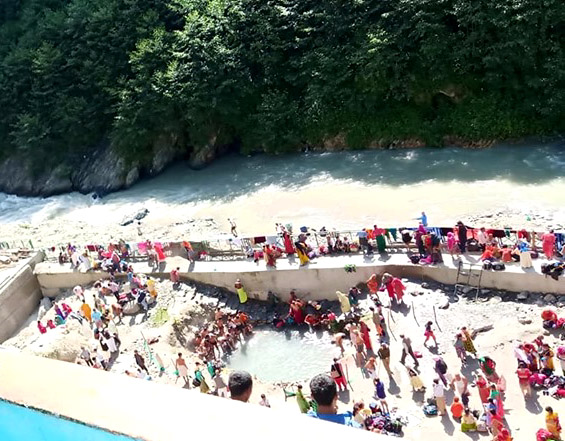
Folklore connection of Gauri Kund is connected with Shiva's
wife Parvati, also known as Gauri. In Hindu folklore, Gauri
committed to penance involving many ascetic and yogic practices
to win over Shiva's affections. Local tradition claims that
Gauri Kund is the spot where Gauri lived while carrying out
these practices and it was here that Shiva finally admitted
His love for Her. They were married at Triyugi Narayan, which
is located nearby. There are hot springs in Gaurikund and
they are converted to bathing places.
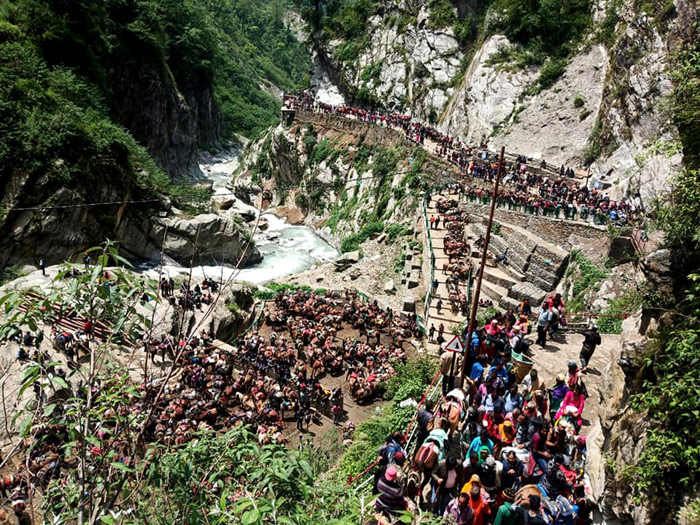
Legend of Gauri Kund
This kund or water well is on the way to main kedarnath temple
that is the main reason why it attracts much of crowd. It
is believed that kedarnath yatra ( pilgrimage ) is incomplete
without visiting this step well ( Gauri Kund ) So people do
visit it in spite place is not maintained as it should be.
Gauri kund is the starting point of 19 km trek to Kedarnath
temple.
Gauri Kund is also associated with the legend of how
Ganesha acquired his elephant head. While bathing in the kund,
Goddess Parvati fashioned Ganesha from the soap suds on her
body, breathed life into Him and placed Him at the entrance
as Her guard. Lord Shiva happened to arrive at the spot and
He was stopped by Ganesha. Indignant at this affront, Shiva
cut off Ganesha's head and Parvati was inconsolable. She insisted
that the boy be brought back to life and Shiva took the head
of a wandering elephant and placed it on Ganesha's body. Parvati
had Her son back and Ganesha acquired the persona by which
He is known all over the Hindu world since then.
Just below the starting point to Kedarnath trek is the Gauri
kund hot spring. The water is boiling at 50° C and one can
only sprinkle that water or use the cold Mandakini river
water to mix and bath. The earlier kund was washed away in
the 2013 deluge and this one has come up again.
Administration at Kedarnath Mandir - Kedarnath Temple
- Kedarnath Dham
The temple was included in the Uttar Pradesh state government
Act No. 30/1948 as Act no. 16,1939, which came to be known
as Shri Badarinath and Shri Kedarnath Mandir Act. The committee
nominated by the state government administers both temples.
The act was modified in 2002, which provisioned adding additional
committee members including Government officials and a Vice
chairman.
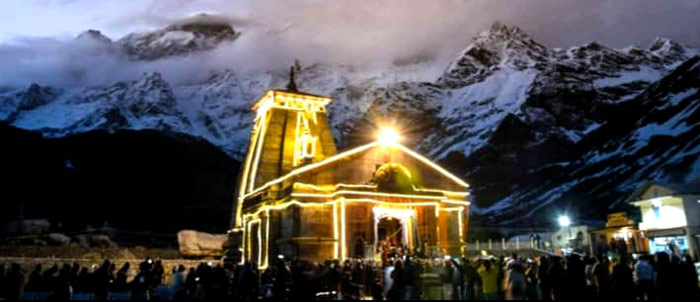
There are a total of seventeen members in the board; three
selected by the Uttaranchal Legislative Assembly, one member
each by the Zilla Parishads of Garhwa, Tehri, Chamoli and
Uttarkashi, and ten members nominated by the state government.
On the religious side, there is a Rawalji (chief priest) and
three other priests: Nayab Rawal, Acharya/Dharmadhikari and
Vedpathi. The administrative structure of the temple consists
of a chief executive officer who executes the orders from
the state government. A deputy chief executive officer, two
OSDs, an executive officer, an account officer, a temple officer
and a publicity officer assist the chief executive officer.
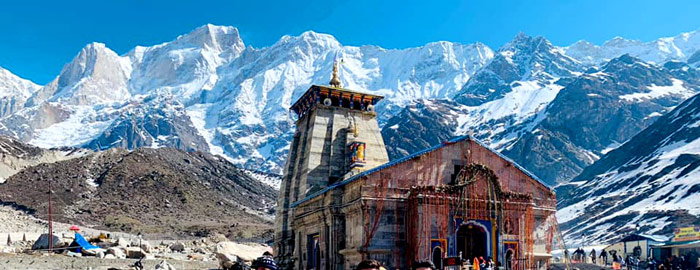
The Badrinath Dham temple has undergone several major renovations
due to its age and damage by an avalanche. In the 17th century,
the temple was expanded by the Kings of Garhwal. After significant
damage in the great 1803 Himalayan earthquake, it was largely
rebuilt by the King of Jaipur. It was still under renovation
as late as the 1870s but these were completed by the time
of the First World War. At that time, the town was still small,
consisting of only the 20-odd huts housing the temple's staff,
but the number of pilgrims was usually between seven and ten
thousand. The Kumbh Meld festival held every twelve years
raised the number of visitors to 50,000. The temple also enjoyed
revenue from the rents owed to it by various villages bequeathed
by various rajas.
During 2006, the state government announced the area around
Badrinath as a no construction zone to curb illegal encroachment.
Timings for Badrinath Dham Prayers
4 am – 9 pm
|
